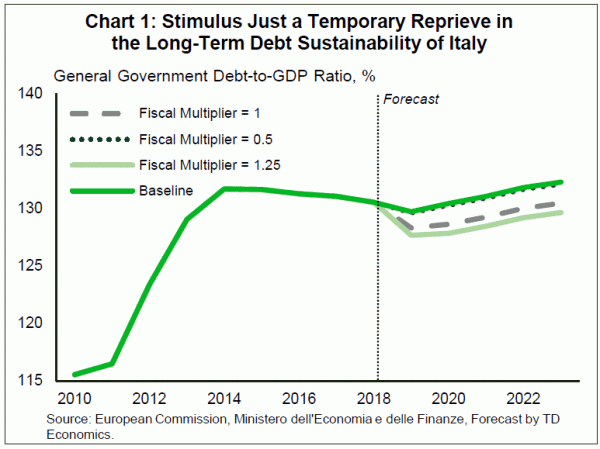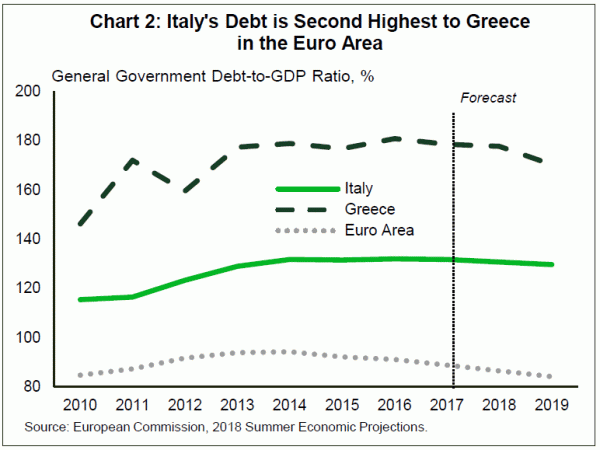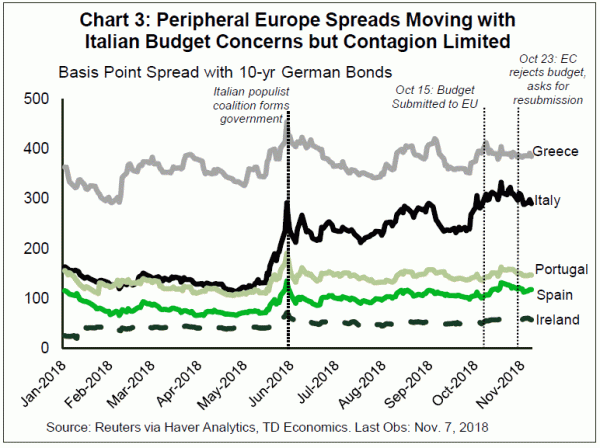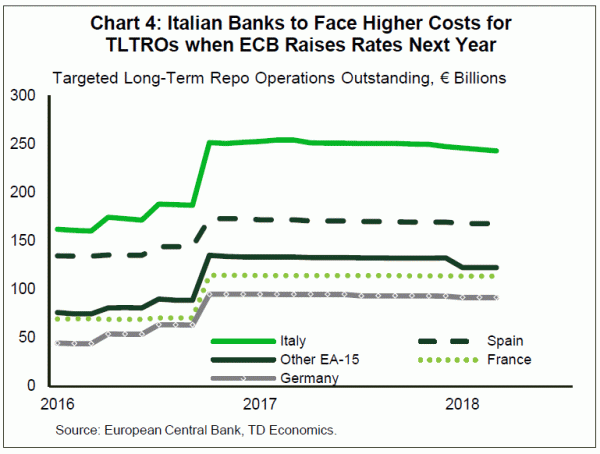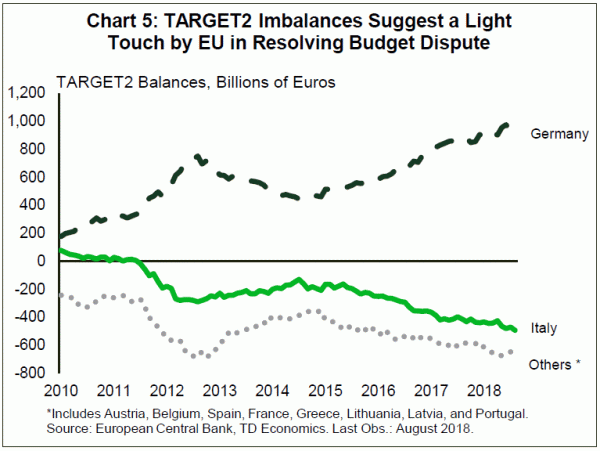Highlights
- Italy’s ruling coalition government has proposed spending plans intended to boost near-term growth, but at the cost of adding more debt down the road. As a result, the European Commission rejected the budget on October 23rd, asking for a revised budget within three weeks’ time.
- The budget standoff has triggered investors to selloff Italian bank shares while also sending the sovereign spread with 10-yr German bunds surging. This is a likely a reflection of the increased chance of investor haircuts as the odds of an Italian bank bailout, backstopped in part by the ECB, in the years ahead have increased.
- A new budget, just days away, could include some marginal spending cuts, and possibly a VAT hike to ease concerns about the revenue side of the ledger. This should avoid a further deterioration in financial conditions as fears of a future economic crisis subside. However, this is unlikely to be the last standoff that we witness between the Italian government and the EU, suggesting further bouts of market volatility to come.
Now that U.S. midterm elections are out of the way, financial markets will return focus to other ongoing geopolitical themes, such as the budget standoff between Italy and the European Union (EU). Italy’s populist governing coalition has proposed a budget that is deemed to violate EU fiscal rules. As a result, Italy now risks having its debt downgraded to junk status, further imperiling an ailing banking sector, and threatening to rekindle broader debt sustainability concerns in the periphery.
Italy has been struggling to boost growth and create jobs since the euro crisis. Growth has been gradually perking up in the last couple of years, and the unemployment rate has been improving. However, its coalition government, elected with a popular mandate, has put forward a spending plan intended to boost near-term growth at the cost of making its debt load less sustainable in the long-run.
At face value, the government spending plan contains some good ideas that should help kickstart a slumbering economy facing severe supply-side challenges. What’s missing from the budget, however, is a plan to boost revenue and thus make the near-term spending more sustainable in the long-run. What’s more, the anti-establishment rhetoric and actions of the coalition government is politicizing a generally mundane annual exercise at the potential cost of Italy’s financial market access.
In the end, negotiations with the EU will likely result in Italy’s government making some marginal spending and revenue concessions in order to reduce financial stress. But, this is unlikely to be the last standoff between the Italian government and the EU, suggesting further bouts of market volatility yet to come.
What’s in the Budget
After weeks of consultation, the European Commission rejected Italy’s 2019 budget proposal that would see the public deficit increase to 2.4% of GDP.1 All told, the budget would cost €37bn, with about 59% of spending expected to be debt financed. The major items include:
- Pension reform and early retirement. Up to 400k people could become eligible to retire at age 62. Currently the retirement age is 65. These changes are expected to take effect in February, and cost about €7bn.
- Universal basic income. Often deliberated, but rarely implemented, the budget follows through on the Five Star Movement’s (M5S) campaign promise to allow for a means tested universal basic income of €780 per month for the least well-off. This is limited to Italians or foreigners legally resident for at least five years, and is intended to provide the necessary support to encourage people to get back into the job market. Similarly, the minimum pension is slated to rise to €780. Together, these measures are expected to improve the economic well-being of 6 million people, at a cost of €9bn-€10bn, including a €1bn effort to improve job centres.
- Tax amnesty and reform. A tax amnesty, largely anticipated to benefit wealthy Italians that have avoided paying taxes in Italy, is expected to raise more than €2bn in revenue. A flat tax of 15% is expected to affect more than a million self-employed including artisans with less than €65k in annual sales.
- No increase in the value-added tax (VAT) in 2019, and a reduction in the scheduled increase in 2020 and 2021. Although sales tax increases are unpopular, EU fiscal rules require a VAT increase when a government runs sustained general budget deficits. The budget scraps the scheduled increase that was set to take place in January that would have taken the VAT up 3 percentage points by January 1, 2021.2 The elimination of automatic VAT increases is expected to cost the Italian government about €12.5bn annually. However, the budget does book additional revenue of €640 million in 2019 due to increased taxes on gambling and some privatization of state assets.
- Public infrastructure. The budget calls for a €15bn increase in infrastructure investment over the next three years. This is in addition a boost in infrastructure spending by about €38bn over the next fifteen years.
- Spending cuts. A savings of €0.5bn a year is expected due to the realization of internal efficiencies, and another €0.5bn from reduced spending on managing and housing migrants. A further €330 million in annual savings are expected to be found by capping “golden” pensions at €4,500 a month.
Longer-Run Sustainability is the Key Concern
With a €22bn budget hole that could have been mitigated by the automatic VAT hikes, it is little wonder that the proposed budget has triggered concerned from both the European Commission and financial markets. Past Italian governments have promised to reduce the general budget deficit to about 0.7% of GDP, placing this budget about 1.7 percentage points off of previous promises. What’s more, the proposed budget plan would end a fifteen year streak of successive primary budget surpluses in excess of 1%, a fact that has helped to keep borrowing costs in check.
Italy’s defense of its budget is that other nations that have violated EU fiscal rules by posting large government deficits have not faced the same pushback. France is one such example. It is not considered in violation of EU fiscal rules due to its implementation of structural reforms. While often viewed as rigid framework, the Growth and Stability pact has some flexible elements, allowing, for example, European governments to run deficits in order to mitigate any economic drag from undertaking structural reforms. Italy’s 2019 budget proposal does commit to a timeline for undertaking structural reforms, but it appears that the European Commission’s values actions more than promises.
Ultimately, the greatest concern is what happens in the years ahead, after the fillip to growth provided by the spending boost outlined in the budget fades. Once slow growth returns, the only legacy of the stimulus may be a deterioration in Italy’s debt-to-GDP ratio (Chart 1). This is problematic, because Italy’s longer term prospects for growth are facing the challenge of an aging labour force that will raise its old-age dependency ratio and further stress finances. Labour market reforms such as those in the budget plan are a step in the right direction, but more will need to be done in order to prevent future labour shortages.
Financial Risks Loom Large
Economics and politics aside, the financial reality is that, like Greece and Japan, Italy has little fiscal space to engage in stimulus spending. At 130%, Italy’s debt-to-GDP ratio is the second highest in the Euro Area after Greece (Chart 2). Italy has always had a difficult time building confidence with investors. Prior to the euro’s adoption, Italian governments were notorious for running fiscal deficits and monetizing debt, stoking inflation and depreciating the lira. This lack of credibility continues to haunt Italy, despite being the third largest Euro Area economy and an important European financial centre. As a result, since the formation of the populist coalition government in June, interest rates on long-term Italian debt have risen on concerns of a return to fiscal imprudence, and are currently trading about 300 basis points higher than equivalent German debt (Chart 3) – remarkably only 40 basis points lower than Greece. This reflects concerns that mounting deficits will lead to an unsustainable rise in debt that could result in a bailout program, an Italian banking crisis, or both, thus implying haircuts for investors in the years ahead.
Indeed, investors in longer-term Italian debt and banks have good reason for concern. Although the trigger is the future rise in already elevated debt levels, the more immediate concern is what happens to Italian finances once the ECB begins normalizing monetary policy. This will inevitably lead to a repricing in Italian debt that is likely to exacerbate the sustainability issue.
With the ECB’s bond buying program likely to end in December, the next step is to cease reinvestments. This could take place as early as 2020. Anticipation of this has already led investors to demand a higher premium to purchase lower quality debt. The recent downgrade in Italian bonds by ratings agencies is consistent with the fear that Italian sovereign bonds are inching closer to junk status, a development that would trigger financial market panic as concerns about broader contagion from an Italian economic crisis come to the fore. Layering on these concerns would be the potential for the ECB to cease reinvesting proceeds from the maturing of asset holdings in Italian debt if Italy was deemed ineligible due to its credit risk.
The risk doesn’t end there. The combination of asset purchases and long-term repo operations announced by the ECB in 2016 helped drive Italian banks to purchase sovereign bonds as part of their efforts to recapitalize. As a result, solvency concerns have extended beyond the sovereign into the Italian banking sector already laden with a large pile of non-performing loans. As the ECB is set to move up short-term interest rates next fall, more than €250bn in targeted longer-term refinancing operations (TLTROs) will ultimately reprice higher in 2020, biting into profit margins and tightening lending conditions further (Chart 4). Italy’s Finance Minister, Giovanni Tria, was quoted recently as saying that a move in the 10-year yield spread with German bunds to 400 basis points may be the point at which Italy would have to act in order to reduce stress on its banking sector.3 The move down in Italian bank shares this autumn is indicative that investors are already pricing in a chance of a banking sector default.
Low Risk of Budget Impasse Leading to Crisis
The fact of the matter is that, unlike Greece, Italy is too big to fail. This is further evident by the size of the TARGET2 balances owed to Italy’s Euro Area peers, namely Germany (Chart 5). Having learned from the euro crisis, EU institutions are taking a more proactive stand to prevent the Italian economy from spiraling downward into a debt crisis. The unprecedented step taken by the European Commission to request a more sustainable 2019 budget is evidence of this proactive approach. What’s more, the ECB is likely to step in and provide liquidity to European banks, including Italian ones, in the event of financial stress. This may include another longer-term repo operation that would reduce the pressure on bank margins as interest rates begin to rise next September.
In the days ahead, Italy is expected to produce a revised 2019 budget that is likely to feature marginal reductions in spending, and could well feature at least one VAT increase – a concession that should placate near-term revenue concerns. That said, even if the current budget ordeal is resolved without triggering a collapse in the ruling coalition government and fresh elections, a similar standoff is surely to happen again next year for the 2020 budget year.
All told, the budget standoff is proving to be a costly endeavour for all parties. However, it’s unlikely to result in an Italian economic crisis. That said, if this proves to be a political rather than economic stand for the EU, future clashes all but guarantee more bouts of financial market volatility as investors question the future of the euro and European project.
End Notes
- Italian Fiscal 2019 Draft Budget: https://ec.europa.eu/info/sites/info/files/economy-finance/2019_dbp_it_en_1.pdf
- Schedule of VAT Increases for Italy: https://home.kpmg.com/xx/en/home/insights/2017/11/tnf-italy-vat-rate-increases-delayed-in-draft-budget-law-2018.html
- “Italy’s Tria fails to halt market fears over budget talks with EU”, Financial Times, October 9, 2018. https://www.ft.com/content/5c88e3c0-cbac-11e8-b276-b9069bde0956




